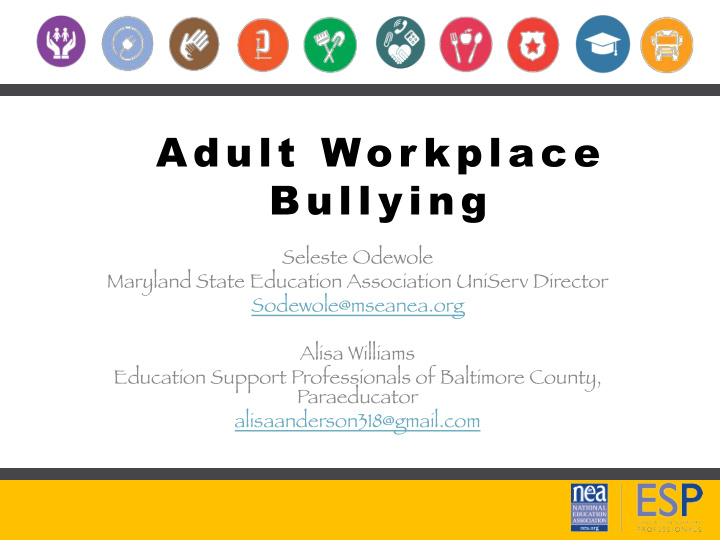



A dul t Wor kpl ace B ul l yi ng Seleste Odewole Maryland State Education Association UniServ Director Sodewole@mseanea.org Alisa Williams Education Support Professionals of Baltimore County, Paraeducator alisaanderson318@gmail.com
NEA Competency Leading Our Professions: Advocates for quality inside our • professions and promotes our union’s role in advancing education transformation and student learning. – Advocates for policies and strategies that positively impact our professions and student learning • Level 1: Foundational: Understands the policies and strategies that impact our professions and student learning • Level 2: Mobilizing & Power Building: Forges alliances and agreements that positively impact our professions and student learning • Level 3: Agenda Driving: Leads our professions by anticipating challenges and putting in place proactive strategies
Workshop Goals • To understand characteristics and effects of workplace bullying • To increase knowledge in appropriate strategies in dealing with difficult behaviors • To develop strategies to improve workplace environment
What is workplace bullying?
Workplace bullying is… • Repeated • Health-harming to target • Intimidating, threatening, humiliating , or sabotaging behaviors • Often prevents work from being done • By a supervisor or coworker (Namie &Namie, 2009, p. 3) The Healthy Workplace Campaign
Is there a difference? Bullying Harassment Discrimination No legal definition EEOC provides a legal EEOC provides legal definition definition Bullying is not target Unwelcome conduct An employer treats an specific that is based on race, applicant or employee color, religion, gender less favorability based (including pregnancy), on age, disability, national origin, age genetic information, (40 or older), national origin, race, disability or genetic color, religion, or information (e.g. sexual orientation. AIDS, Ebola, etc)
Majority of bullying is legal • Bullying is not harassment, however harassment is a form of bullying • Bullying is often not discrimination, however discrimination is a form of bullying • Bullying is not target specific
Bullying is common Witnessed Only Been Bullied Currently Bullied
The Bully
Types of bullies
Bullying Tactics
Bullying tactics • Blame others for “errors” • Public shaming • Set unreasonable job • Insult demands • Discount • Criticize ability accomplishments • Inconsistently comply • Exclude with rules • Yell/scream • Threaten job loss • Steal credit • Use sarcasm • Invade one’s “personal • Interrupt space” • Two-faced attacks • Dirty looks
Bullying Behaviors… • Intimidate • Degrade • Offend • Undermine • Embarrass • Humiliate
Effects of Bullying
Individual Effects • Increased fear • Difficulty sleeping • Decreased productivity • Increased anxiety • Decreased job • Anger satisfaction • Depression • Chronic fatigue • Irritability
Systematic Effects • Increased employee turn over • Increased employee absenteeism • Increased employee distraction • Decreased employee performance
Recap www.apaexcellence.org/bullying
Strategies for empowerment
Systematic Strategies • Anti-workplace bullying laws www.workplacebullying.org • Board policies • Contract language • Worksite culture
Individual Strategies • Change how you see • Limit exposure to the things individual(s) and/or situation • Develop emotional detachment • Build pockets of safety, support, and sanity • Stand up for yourself • Fight and win the right battles • Recognize that you might be able to take it, but question if you need to
Approaches to Carry out the Individual Strategies • Aggressively • Passively • Assertively
Aggressive Approach • Direct and/or indirect • Honest and/or dishonest • Violates rights of others • Win-Lose
Passive Approach • Inactive and/or indirect • Communicates inferiority • Leads to being a victim • Lose-Win
Be Assertive • Open, honest, direct • Places our wants on an equal par with others • Communicates self-respect and respect for others • Fosters collaboration • Win-Win
Empowerment Empowerment is the process that allows one to gain the knowledge, skill-sets and attitude needed to cope with the changing world and the circumstances in which one lives.
Share your Thoughts • Please complete the evaluation for this breakout session! • Please visit the Leadership Development Resources website at www.nea.org/leadershipdevelopment
Recommend
More recommend